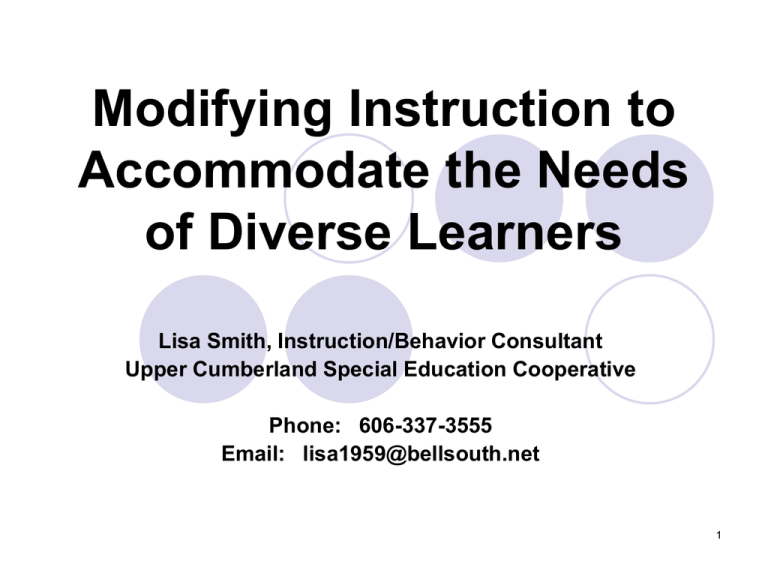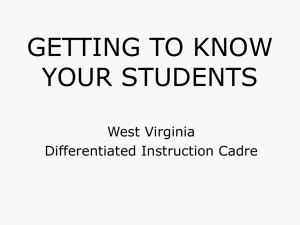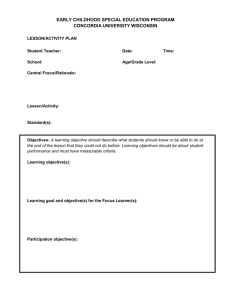Instructional Modifications and Accommodations Powerpoint
advertisement

Modifying Instruction to Accommodate the Needs of Diverse Learners Lisa Smith, Instruction/Behavior Consultant Upper Cumberland Special Education Cooperative Phone: 606-337-3555 Email: lisa1959@bellsouth.net 1 Today’s Goals… To provide participants with an overview of the process of modifying instruction to meet the needs of diverse learners To provide participants with an overview of the frustration, anxiety and tension students with learning difficulties experience To engage in activities and conversations for the purpose of enhancing the participants’ knowledge of the use and development of techniques for modifying instruction 2 Presentation Techniques (Utilizing the Principles of Adult Learning Theory) Discussion Small and large group activities Cooperative learning strategies (i.e., jigsaw, think-pair-share) Self-Reflection Question and answer sessions Active Learning Strategies (i.e., role play, scenarios, simulations) others 3 Students come to school with an expanded array of readiness levels, interests and learning profiles. Their interests may vary from surviving on the street to launching rockets. 4 Then we have issues like: Gender Culture Learning style Intelligence Ability All shape the varied ways in which students approach and respond to learning. This calls on us to modify, or differentiate, instruction in response to students varied readiness levels, interests, and learning profiles. 5 There is ample evidence that tracking struggling learners impairs their chances for high quality learning opportunities. 6 Students on each end of the learning spectrum have “nonstandard” learning needs so differentiated learning opportunities are advantageous to them. 7 All students within the learning spectrum benefit from flexible classrooms in which interests, learning profiles and readiness needs help sculpt instruction. 8 All learners should work with “respectful tasks” Offer tasks that encourage them to think at higher levels of thinking Opportunities to be active learners Equally interesting and engaging tasks Work with a wide variety of peers over time Be involved with learning that is new to them Pushed a little beyond their individual comfort zones in knowledge, insight, thinking, skills, and production ESSENTIAL TO DIFFERENTIATION 9 Flexible grouping of students enables all learners to work in a wide variety of configurations Peers of similar readiness Similar interests Learning profiles Mixed readiness, interest, and learning profiles Whole group Independently Student choice 10 Goal… Equal playing field Balance to ensure support 11 Continuum of Services 707 KAR 1:350, Section 1(9/2000) Direct/Indirect Instruction The continuum shall include the alternative placements of: Instruction in Regular Classes Special Classes Special Schools Home Instruction Instruction in hospitals and institutions 12 What is a Modification? A change in the way a teacher: presents information tests students has students practice new skills so that every student has a chance to succeed. 13 Making Modifications… To meet the diverse needs of students in our classrooms, modifications are necessary. Modifying curriculum can be very time consuming for teachers and delivering the modified instruction for some students may be difficult with one teacher and a full classroom. Collaborative teaching makes modified teaching more easily accomplished through shared responsibility for planning and instruction. 14 Who Is Responsible for the Design and Implementation of Modifications/Extensions? YOU ARE...The teacher who provides the instruction and assessment for the student is ultimately responsible for the implementation of the modifications/extensions. WE ARE… The team of teachers who work together to identify specific modifications/extensions that students will need for daily instruction. 15 What is Fair? Fair does not mean that everyone receives the same thing, but that everyone receives what they need to be successful. Richard LaVoie F.A.T. City 16 Schumm, Vaughn, and Harris, 1997 What SOME students will learn What MOST students will learn What ALL students will learn 17 Types of Modifications There are at least 6 types of modifications: Size Time Level of Support Instruction Difficulty Output 18 Types of Modifications Size: Modify the number of items that some learners are expected to learn Time: Modify the time allotted and allowed for learning, task completions or testing. 19 Types of Modifications Level of support: Increase the amount of help by the special teacher or other sources of support such as: Teaching assistants; Adult volunteers; Peer tutors; or Cross age tutors. 20 Types of Modifications Instruction: Modify the instruction to be delivered to some learners: More visuals; Hands-on leaning; Models; Taped books or stories; Outline notes; or Cooperative learning groups 21 Types of Modifications Difficulty: Modify the Skill level; Problem type; Rules For how some learners may approach the work 22 Types of Modifications Output: Modify how some learners can respond to instruction such as: Answering questions orally instead of writing Showing knowledge with hands-on materials 23 Video…. How Difficult Can This Be? The F.A.T. City Workshop 24 To Reduce FEAR and ANXIETY…. Never force the student to read out loud in class Never have the student write on the board Don’t allow students to grade papers or tests Never call on the student unless they volunteer Make sure your classroom is a safe place to make mistakes 25 Class Work and Assignments…. Break assignments into small steps Give simple, oral directions and provide a written copy of these directions when possible. Limit the amount of copying to be done whenever possible. Give the student a desk copy of what the class is to copy from the board. 26 Techniques for Testing Quiz often with brief tests instead of fewer, long tests. Avoid negative questions. (example: “Which one is not the same?”) The process of testing can be less stressful if the modality is varied. Use your creative abilities to devise alternate ways to assess knowledge rather than always relying on traditional tests. Evaluate the student’s knowledge in less formal 27 situations to reduce stress and accentuate the level of learning. Social and Emotional Needs…. Encourage, encourage, encourage! No “buts” about it! Find activities to do in which the child is successful and takes pleasure! Make sure the student knows that you understand that he is working hard when he is! 28 Activity… Examine the types of modifications listed and identify which type of modification is indicated by the activities listed… 29 Choose from these types of modifications and descriptions… -Assessment -Delivery -Difficulty -Environment -Time -Level of Support -Organization -Participation -Size Adapt the way instruction is delivered to the learner. Adapt the time allotted and allowed for learning, task completion, or testing. Increase the amount of personal assistance with a specific learner. Adapt the skill level, problem type, or the rules on how the learner may approach the work. Provide structure for completing tasks. Adapt the number of items that the learner is expected to learn or complete. Adapt the extent to which a learner is actively involved in a task. Adapt physical setting. Adapt how the student can respond to instruction. 30 13 Extensions… Purpose and Appropriateness Complexity of Task Size of Task Time Pace Environment of Learning Participation Motivation Order of Learning Procedures and Routines Application and Demonstration of Knowledge Level of Support and Independence Resources and materials 31 Wrap-Up… Questions???? Follow-Up Evaluations 32 Contacting Today’s Presenter…. Lisa Smith, Instruction/Behavior Consultant Upper Cumberland Special Education Cooperative Phone: 606-337-3555 Email: lisa1959@bellsouth.net 33






